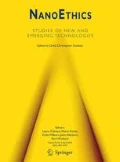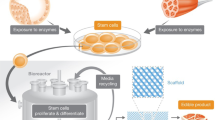Abstract
Nanotechnologies that have been linked to the possibility of enhancing cognitive capabilities of human beings might also be deployed to reduce or eliminate such capabilities in non-human vertebrate animals. A surprisingly large literature on the ethics of such disenhancement has been developed in response to the suggestion that it would be an ethically defensible response to animal suffering both in medical experimentation and in industrial livestock production. However, review of this literature illustrates the difficulty of formulating a coherent ethical debate. Well structured arguments for disenhancement can be made on the basis of mainstream views on the basis of ethical obligations to animals, but these arguments have not been persuasive against the moral intuition that disenhancements are unethical. At the same time, attempts to ground these intuitions in a coherent philosophical doctrine have been plagued by logical fallacies and question begging assertions. As such, the debate over animal disenhancement forecasts an enduring conundrum with respect to the core question of transforming the nature of sentient beings, and this conundrum is logically independent of claims that relate either to the distinctive of human beings or to issues deriving from the emphasis on enhancement.
Similar content being viewed by others
References
Appleby MC (1999) What should we do about animal welfare? Blackwell Science, Oxford
Balzer P, Rippe KP, Schaber P (2000) Two concepts of dignity for humans and non-human organisms in the context of genetic engineering. J Agric Environ Ethics 13:7–27
Bovenkirk B, Brom FWA, van den Bergh BJ (2001) Brave new birds: the use of integrity in animal ethics. Hastings Cent Rep 32(1):16–22 doi:10.2307/3528292
Brambell FW (1969) Report of the technical committee to enquire into the welfare of animals kept under intensive livestock husbandry systems. Her Majesty’s Stationery Office, London, UK
Colwell RK (1989) “Natural and unnatural history: biological diversity and genetic engineering”. In: Shea WR, Sitter B (eds) Scientists and their responsibilities. Watson Publishing International, Canton, OH, pp 1–40
Davis K (1996) “The ethics of genetic engineering and the futuristic fate of domestic fowl”. United Poultry Concerns Website. Available at http://www.upc-online.org/genetic.html (accessed January 13, 2006)
Edelman PD, McFarland DC, Mironov VA, Matheny JG (2005) In vitro-cultured meat production. Tissue Eng 11:659–662 doi:10.1089/ten.2005.11.659
Fox MW (1990) “Transgenic animals: ethical and animal welfare concerns”. In: Wheale P, McNally P (eds) The bio-revolution: cornucopia or pandora’s box. Pluto, London, pp 31–54
Gifford F (2002) “Biotechnology”. In: Comstock G (ed) Life Science Ethics. Iowa State, Ames, IA, pp 191–224
Heeger R (2000) Genetic engineering and the dignity of creatures. J Agric Environ Ethics 13:43–51
Holland A (1995) “Artificial lives: philosophical dimensions of farm animal biotechnology”. In: Mepham TB, Tucker GA, Wiseman J (eds) Issues in agricultural bioethics. University of Nottingham, Nottingham, pp 293–306
Kass L (1997) “The wisdom of repugnance”. The New Republic June 2:17–26
Kastenbaum D (2001) “Analysis: debate over genetically altered fish and meat”. Morning Edition (December 4, 2001). Transcript available online at http://www.npr.org.http://www.npr.org/templates/story/story.php?storyId=1134248 (accessed June 25, 2008)
Lin P, Allhoff F (2007) “Nanoscience and nanoethics: defining the disciplines”. In: Allhoff F, Lin P, Moor J, Weckert J (eds) Nanoethics: the ethical and social implications of nanotechnology. Wiley-Interscience, Hoboken, NJ, pp 3–16
Mauron A (1989) “Ethics and the ordinary molecular biologist”. In: Shea WR, Sitter B (eds) Scientists and their responsibilities. Watson Publishing International, Canton, OH, pp 249–265
McNaughton P (2004) Animals in their nature: a case study on public attitudes to animals genetic modification and ‘nature’. Sociology 38:533–551 doi:10.1177/0038038504043217
Midgley M (2000) Biotechnology and monstrosity. Hastings Cent Rep 30(5):7–15 doi:10.2307/3527881
Ortiz SEG (2004) Beyond welfare: animal integrity, animal dignity and genetic engineering. Ethics Environ 9:94–120 doi:10.2979/ETE.2004.9.1.94
Regan T (1983) The case for animal rights. University of California Press, Berkeley
Regan T (1995) “Are zoos morally defensible?”. In: Norton BG, Hutchins M, Stevens EF, Maple T (eds) Ethics on the ark. Smithsonian Institution, Washington, DC, pp 38–51
Regan T (2003) Animal rights, human wrongs: An introduction to moral philosophy. Rowman and Littlefield, Lanham, MD
Rollin B (1986) “The frankenstein thing”. In: Evans JW, Hollaender A (eds) Genetic engineering of animals: An agricultural perspective. Plenum, New York, pp 285–298
Rollin B (1995) The frankenstein syndrome: Ethical and social issues in the genetic engineering of animals. Cambridge University Press, New York
Rollin B (1998) “On telos and genetic engineering”. In: Holland A, Johnson A (eds) Animal biotechnology and ethics. Chapman and Hall, London, pp 156–187
Rollin B (2006) Science and ethics. Cambridge University Press, New York
Rutgers B, Heeger R (1999) “Inherent worth and respect for animal integrity”. In: Dol M, Fentener van Vlissingen M, Kasanmoentalib S, Visser T, Zwart H (eds) Recognizing the intrinsic value of nature. Van Corcum, Assen, pp 41–53
Savory CJ (1995) Feather pecking and cannibalism. Worlds Poult Sci J 51:215–219 doi:10.1079/WPS19950016
Sandøe P, Holtung N, Simonsen HB (1996) Ethical limits to domestication. J Agric Environ Ethics 9:114–122
Sandøe PB, Nielsen L, Christensen LG, Sørensen P (1999) Staying good while playing God—the ethics of breeding farm animals. Anim Welf 8:313–328
Sapontzis SF (1991) We should not manipulate the genome of domestic hogs. J Agric Environ Ethics 4:177–185 doi:10.1007/BF01980315
Singer P (1975) Animal liberation. Avon Books, New York
Singer P (2002) Animal liberation, revised edition. HarperCollins, New York
Tausin R (2002) Furnished cages and aviaries: production and health. Worlds Poult Sci J 58:49–63 doi:10.1079/WPS20020007
Thompson PB (1997) Ethics and the genetic engineering of food animals. J Agric Environ Ethics 10:1–23 doi:10.1023/A:1007758700818
USDA (United States Department of Agriculture) 2006. “ARS Project: identification and manipulation of genetic factors to enhance disease resistance in cattle.” Available at http://www.ars.usda.gov/research/projects/projects.htm?ACCN_NO=405817&showpars=true&fy=2003 (accessed January 13, 2006). Page last modified Jan. 12, 2006
Varner G (1990) Biological functions and biological interests. South J Philos 27:251–270
de Vries R (2006) Genetic engineering and the integrity of animals. J Agric Environ Ethics 19:469–493 doi:10.1007/s10806-006-9004-y
Warkentin T (2006) Dis/integrating animals: ethical dimensions of the genetic engineering of animals for human consumption. AI Soc 20:82–102 doi:10.1007/s00146-005-0009-2
Author information
Authors and Affiliations
Corresponding author
Rights and permissions
About this article
Cite this article
Thompson, P.B. The Opposite of Human Enhancement: Nanotechnology and the Blind Chicken Problem. Nanoethics 2, 305–316 (2008). https://doi.org/10.1007/s11569-008-0052-9
Received:
Accepted:
Published:
Issue Date:
DOI: https://doi.org/10.1007/s11569-008-0052-9




